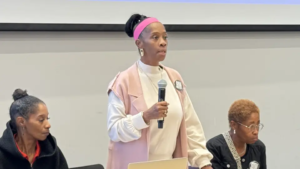Although they don’t wear uniforms, military children also serve their country.
Updated April 24, 2024 | Reviewed by Hara Estroff Marano
KEY POINTS
- More than two million American children have at least one parent serve in the military since September 11.
- Military service carries proud but sometimes painful family legacies.
- The service of military children is rarely recognized outside the military community.
By Cassidy O’Neill, Carla Schnitzlein, D.O., and Harold Kudler, M.D.
Seven-year-old Olivia and her older sister laugh as they cover their dozing father with a Barbie sleeping bag. Slumped over a chair, his arm peeks out from one side, his hand gripping an empty jug of wine. In their play, he has become Barbie. The girls continue to giggle as Dad/Barbie starts to speak in slurred words. With welling tears and shortened breaths, Dad/Barbie gives voice to what he would later explain are combat memories.
He speaks of being a young soldier, running in fear toward safety. As if reliving rather than simply remembering, he describes his attempt to leap over a barbed wire fence only to snag his leg in the prickly wire. He falls to the ground and succumbs to his cuts. Unable to run, he calls out for the fellow squad member he had lost track of in the heat of battle.
Olivia, the daughter of a combat veteran, asked us to share this childhoodmemory during the Month of the Military Child. Her purpose is to spark curiosity and open conversations about the 1.6 million dependent military children of today’s service members, the total 2.1 million children of those who have served since September 11, 2001, and the more than three-quarters (77%) of American adults aged 50 and over who have an immediate family member—spouse, parent, sibling or child—who has served in the military.
Now an adult, Olivia often reflects on this surreal and confusing childhood memory because it was one of the only combat stories her father would later explain to her. Sorting through this and other memories she had, Olivia has uncovered the hard truths and unimaginable tragedies her father tried to bury in an effort to protect her innocence.
She also came to realize that, by imaginatively framing her father’s flashback as Barbie’s, she was shielding herself from the unthinkable hurt that he carried. When she was little, she thought of her father as the strongest man on earth and her protector. How could her young mind reconcile those beliefs with her growing realization of his struggles and vulnerabilities? Her evolving perspective helped Olivia come to terms with the conspiracy of silence that both protected and inhibited family life during her early years.
Family History
Olivia’s father followed in his own father’s footsteps by joining the Army at age 18. Her father’s choice was honorable in Olivia’s eyes, yet decades elapsed before he, himself, could take pride in his service.
The war cost him his eyesight. His severely diminished vision left him unemployed and unable to drive, cook, or even play board games with his children. Ashamed of his limitations and increasingly anxious in social settings, Olivia’s father sank into isolation and, eventually, into a deep depression. Her parents divorced shortly after he hit this low point in his life.
After her mother left, seven-year-old Olivia and her older siblings came to assume parental roles in their father’s household. They learned how to adapt family routines to accommodate their father’s disability. By helping him cook, assisting him in social settings, and buying hearing-based games like Bop It, they created new ways of engaging him and keeping him at ease.
Meanwhile, her father’s healthcare team at the Veterans Affairs (VA) hospital helped him increase his skill and confidence in navigating his environment safely despite his visual impairment.
Unfortunately, despite everyone’s best efforts, Olivia’s father’s legal blindness, post-traumatic stress disorder (PTSD), and intermittent depressive episodes were further complicated by his turning to alcohol. In this, too, he retraced his own father’s course after the Vietnam War.
article continues after advertisement
In grade school, Olivia was angered by her father’s alcohol use. She often hid his bottles or poured them out in the sink. As she matured, she realized that her father drank in a vain attempt to cope with his PTSD, depression, and visual impairment.
Unfortunately, alcohol only worsened her father’s dark moods and led to criticism and withdrawal on the part of other family members. This further accelerated the vicious cycle of his alcohol use disorder.
Recovery
Fortunately, Olivia’s father had the strength to work toward sobriety. Over time, Olivia found that, by offering a listening ear and consistently expressing her love and belief in him, she helped to support his abstinence.
Her father’s VA healthcare team contributed, too, by treating him with respect and providing both professional and peer support. He came to value VA group therapy because it comforted him to be surrounded by fellow veterans and caring staff members. The VA provided her father with something he deeply needed: a safe space in which to share his story, restore his morale, and develop perspective on his life.
The combined efforts of his family and care team, coupled with his own resilience, enabled Olivia’s father to avoid drinking, manage his anxiety, and perform the daily activities required to take better care of himself and others. His example helped Olivia and her siblings find the strength they needed to cope with challenges they were to encounter later in life.
Having observed, firsthand, the impact that high-quality, compassionate care can have on a veteran’s well-being, Olivia has chosen a career that serves veterans and their families.
Being the daughter of a veteran will always be at the core of Olivia’s identity. Hers is the story of but one military child among millions. Fortunately, not all have to contend with a parent’s visible or invisible wounds, but they do share important challenges.
The Challenges Faced by Military Children
Although they don’t wear uniforms, military children also serve. Unfortunately, their service is rarely recognized by others outside the military community. Along with their parents, they usually relocate across the nation or around the globe every two to three years. When they move, they leave behind friends, schools, congregations, teams, and other sources of structure and support that most children rely on for a sense of stability.
Although military children are members of a vast subset of American youth, they have limited opportunities to connect with peers for mutual support and understanding.
Millions of military children have endured a parent’s absence for months or years while knowing their parent was in harm’s way. While reunions may be joyful, they are also challenging in that each family member has to contend with significant changes that often have taken place during the separation.
article continues after advertisement
Military children are part of military culture even if they themselves never enlisted. A tenet of that culture is to deal with a challenge (including a challenging thought or feeling) by “sucking it up” rather than reflecting on it or sharing concerns with others. While this can be a helpful strategy in survival situations, it may predispose military children to distance themselves from their own thoughts and feelings and to become cautious about intimacy with others.
Olivia offers her personal history during the Month of the Military Child to encourage other military children to share their own experiences, to embrace adversity without shame, and to carry a sense of honor and pride in their military roots.
Every military child is unique, yet all share experiences that can teach them to care for others and be resilient in their own lives. Olivia also hopes that her story will help her fellow citizens to be curious about and sensitive to the proud but sometimes painful family legacies of military service.
Cassidy O’Neill is a medical student at the Frank H. Netter School of Medicine; Carla Schnitzlein, D.O., is a psychiatrist at the Institute for Living; Harold Kudler, M.D., is chair of the GAP Military and Veterans Committee.
References
Month of the Military Child: Celebrating Military-Connected Children, Youth and Teens. https://www.defense.gov/Spotlights/Month-of-the-Military-Child/. Retrieved April 18, 2024.
Resources:
Military OneSource: Taking Care of Our Military Children
The Military Child Education Coalition (MCEC)
Sesame Street Resources for Military Families
Consultations for New Military Parents
The Military Family Research Institute at Purdue University
———————————————————




